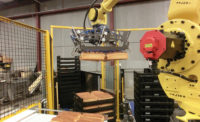Perspectives on sanitation efficiencies




An engineer’s perspective on cleaning efficiencies is scary on its own merit—and I’m certainly going to date myself here—but remember the old boil tanks sanitation was so proud and protective of? They were primitively constructed, scary beasts with some valves and piping welded into the underside to act as a drain, which deposited its contents directly onto the floor. The large, wide-open steam pipe would come from above and was inserted maybe 18 inches into the deep, throttled merely by a gate valve. Its only intent was to superheat a caustic concoction that could eat chrome off a car bumper (yes, car bumpers were chromed back then…).
Maintenance was given the daunting task of dismantling guards, removing catch pans and taking off the table top chain (which used to be made of steel), and sanitation would load it all up onto a pan truck or ingredient cart, bring it to the “wash room” and boil it for several hours. Occasionally, depending on the materials, some of the items would no longer exist as they were literally boiled to death. Primitive as it was, whatever made it through the bath had nothing on it. Perhaps slightly rusted or corroded, but it did the job and we didn’t kill anyone with our products.
Today, between standards, regulations, allergens and everything made out of completely different materials, the boil tanks have outlived their useful lives. Pan trucks are for pans, ingredient carts are for ingredients. Rightfully so, but now what?
Our plants are at capacity or above, and it’s getting impossible to hire qualified, willing, drug-free employees. Where we used to go down two days a week for at least 24 hours we now are lucky to go down one day a week for 12 hours—not to mention those allergen changeovers that we try to schedule at the end of the run, but somehow always end up breaking into the middle of our runs.
It means we have to adapt. We need to work smarter, not harder. We need our lines methodically cleaned and able to pass the swab tests, then put back together and pumping product out again in record time. Our equipment needs to be made out of easily cleaned, lightweight materials, easily taken apart without tools, and be able to be put back together intuitively so the right parts are in the right place. It also needs to stand up to the “foamer,” the replacement of the boil tank.
Wouldn’t it be great if everything could be clean-in-place (CIP)? We do have a lot of processes that we can CIP, and we have a lot places we wash, like trays, baskets, pans, conveyors, etc. Regardless, it’s imperative to use the proper chemicals in the right amounts. Conductivity and pH meters, and precise metering pumps, are necessities.
Fortunately, everything is becoming, better, stronger and cheaper as time goes by. Avoiding bio build-up saves time, energy, resources and chemicals—and money. Build-up makes our refrigeration systems, heating systems and cleaning processes work harder. This shortens their useful life, costing us money without notice. Utilize your chemical companies. They can verify your titration, pH and conductivity levels. You’re paying for that service with every drop of chemicals you purchase—they are the experts.
We have made great strides between the equipment suppliers and the needs of the bakeries with BISSC, and ANSI Z50 standards, but we have to keep this issue front and center. It is certainly not an easy task. The bakeries want cheap, robust, long-lasting, maintenance-free equipment, but the reality is those characteristics are not found in lightweight, easily removed, easily cleaned components—and if they are, it certainly isn’t cheap.
A candid conversation with the folks that perform these duties for us can be our best resources. Efficiencies are not always easy to recognize. However, as a team I think you will be amazed at how many opportunities are available to streamline cleaning and save big. We must encourage employees and make them part of the decision.
BIF, BEMA’s Baking Industry Forum, provides the industry with a strong resource for ideas and expertise based on research and years of experience. Seven bakers and seven suppliers work together as the Baking Industry Forum. This committed group explores issues common to everyone in the baking industry, such as preparations for FSMA, the importance of training, how to hire veterans, safety and more. For more information, visit www.bema.org/bif.
Looking for a reprint of this article?
From high-res PDFs to custom plaques, order your copy today!











